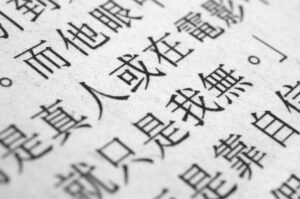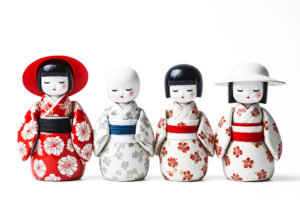Washi paper, a cherished element of Japanese heritage, embodies a rich cultural legacy that extends far beyond mere utility. Derived from renewable plant fibers like mulberry, gampi, or hemp, Washi is renowned for its exceptional strength, smooth texture, and ability to absorb ink. Its name, “wa” meaning Japanese and “shi” meaning paper, reflects its deep-rooted connection to Japanese identity and craftsmanship.
The significance of Washi paper transcends its physical properties. It is revered for its symbolic representation of resilience and grace, echoing the ethos of Japanese aesthetics. This paper has historically been used in calligraphy, origami, and, notably, in traditional crafts like lantern making and doll crafting.
In the world of Washi paper crafts, lantern making stands out as a captivating art form. Washi paper lanterns are not just practical objects but also hold profound cultural symbolism. They illuminate festivals and ceremonies across Japan, casting a gentle glow that epitomizes warmth and community spirit. Craftsmen meticulously select and layer Washi paper to create these lanterns, marrying practicality with artistic expression.
The allure of Washi paper extends to the realm of paper dolls, or origami dolls. These delicate creations are an embodiment of precision and elegance, often folded from intricately patterned Washi paper. Traditionally used in storytelling and as tokens of goodwill, Washi paper dolls reflect the Japanese reverence for craftsmanship and attention to detail.
Decorative techniques further enhance the versatility of Washi paper. Marbling, a method of floating inks on a water surface and transferring them onto paper, infuses Washi with mesmerizing patterns and colors. This technique transforms Washi into an art form, where no two sheets are alike.
In essence, Washi paper crafts embody the essence of Japanese artistry—combining simplicity with sophistication, tradition with innovation. Its adaptability in lantern making, doll crafting, and decorative techniques underscores the enduring appeal of Washi paper within Japan and beyond. As we delve deeper into these crafts, we uncover not just the beauty of Washi paper, but also the timeless narratives woven into its fibers.
Lantern Making with Washi Paper
Washi paper lanterns are not merely decorative objects; they are steeped in history and cultural significance within Japanese tradition. Dating back centuries, these lanterns have illuminated festivals, temples, and homes, symbolizing both practical lighting and spiritual illumination. The use of Washi paper in lantern making underscores the Japanese reverence for natural materials and craftsmanship.
The history of Washi paper lanterns can be traced to the Edo period (1603-1868), a time when papermaking thrived and lanterns became integral to daily life. Craftsmen would meticulously handcraft lanterns using Washi paper, bamboo frames, and sometimes wood or metal supports. Each lantern was a testament to the artisan’s skill and the enduring allure of Washi paper.
For those interested in experiencing the art of Washi paper lantern making, a simple lantern can be crafted with minimal materials and effort. Here’s a step-by-step guide:
Materials Needed:
– Washi paper (preferably lightweight and translucent)
– Bamboo sticks or thin wooden dowels
– Glue or rice paste
– Scissors
– Tea light or small LED light (for illumination)
Folding and Assembling Instructions:
1. Prepare the Frame: Cut the bamboo sticks into four equal-length pieces for the sides and one longer piece for the handle. Alternatively, use thin wooden dowels for a more durable frame.
2. Create Panels: Cut the Washi paper into rectangular panels slightly larger than the frame sections.
3. Attach Washi Paper: Use glue or rice paste to adhere the Washi paper to the frame, ensuring a smooth, even application.
4. Assemble the Lantern: Attach the four sides of the frame together at the corners to form a box-like structure. Secure the longer bamboo stick or dowel as the handle at the top.
5. Final Touches: Trim any excess paper and reinforce the seams as needed. Allow the lantern to dry completely before adding the light source.
Showcasing Styles and Designs:
Washi paper lanterns come in various styles and designs, reflecting regional aesthetics and festival themes. Some feature intricate patterns, while others boast minimalist elegance. Common styles include cylindrical lanterns (chōchin), globe-shaped lanterns (andon), and decorative festival lanterns (bonbori).
Washi paper lantern making encapsulates the essence of Japanese craftsmanship and artistic expression. Whether crafting a simple lantern for ambiance or exploring elaborate designs, the process celebrates the timeless allure of Washi paper within a cultural context that values beauty, simplicity, and tradition.
Creating Paper Dolls with Washi Paper
Washi paper dolls, also known as origami dolls, hold a special place in Japanese culture, embodying a tradition that dates back centuries. These delicate creations are crafted from Washi paper, showcasing the artistry and precision inherent in Japanese origami.
The tradition of Washi paper dolls traces its roots to the Edo period (1603-1868), when origami emerged as a popular pastime among the aristocracy and commoners alike. Originally used in ceremonial rituals and as offerings at temples, Washi paper dolls gradually evolved into decorative and expressive art forms.
Crafting a basic Washi paper doll involves mastering fundamental folding techniques and embracing creative embellishments. Here’s a simple guide to creating a Washi paper doll:
Materials Needed:
– Washi paper (various colors and patterns)
– Scissors
– Glue or adhesive (optional)
– Markers, pens, or Washi tape for decorating
Folding Techniques:
1. Body Base: Begin with a square piece of Washi paper. Fold it diagonally to create a triangle, then fold the two bottom corners up to meet at the top point, forming a smaller triangle.
2. Forming the Body: Fold the sides of the triangle inward towards the center to create a diamond shape. Flip the paper over and fold the bottom point upwards, leaving a small tab at the top.
3. Creating Limbs: Fold the sides of the diamond inward to form the arms and legs of the doll. Use additional paper or trim as needed to achieve desired proportions.
4. Finishing Touches: Decorate the doll using Washi tape for clothing patterns, or use markers and pens to add facial features and details.
Symbolism and Variations
Washi paper dolls carry diverse symbolism and variations across different regions of Japan. In some areas, they are used in storytelling and theatrical performances, representing characters from folklore or historical tales. Each region may have its unique style of crafting and decorating Washi paper dolls, reflecting local customs and aesthetics.
In conclusion, Washi paper dolls exemplify the blend of artistic expression and cultural heritage inherent in Japanese crafts. From their humble origins in ritualistic practices to their contemporary role as decorative artworks, Washi paper dolls continue to captivate with their simplicity and charm, offering a glimpse into Japan’s intricate tradition of paper artistry.
Exploring Decorative Techniques with Washi Paper
Decorative techniques elevate Washi paper from a simple material to a canvas of artistic possibilities. Through methods like marbling, dyeing, and stamping, Washi paper takes on new dimensions of texture, color, and design, reflecting the ingenuity and creativity of Japanese artisans.
Introducing Decorative Methods:
Marbling, dyeing, and stamping are popular techniques used to transform Washi paper into vibrant works of art. Marbling involves suspending pigments or inks on a liquid surface and then transferring them onto paper to create intricate patterns. Dyeing uses natural or synthetic dyes to color Washi paper, while stamping employs carved blocks or stamps to imprint designs onto the paper.
Process of Washi Paper Marbling:
Marbling Washi paper requires a few basic materials and careful execution:
Materials Required:
– Shallow tray or basin filled with water
– Various colors of liquid acrylic or suminagashi ink
– Droppers or brushes for applying ink
– Toothpicks or combs for creating patterns
– Sheets of Washi paper (cut to desired size)
Step-by-Step Instructions:
1. **Prepare the Water Bath:** Fill a shallow tray or basin with water.
2. **Apply Ink:** Using droppers or brushes, add drops of liquid acrylic or suminagashi ink onto the surface of the water. Experiment with different colors and densities.
3. **Create Patterns:** Use toothpicks or combs to gently swirl and manipulate the ink on the water’s surface, forming unique patterns and designs.
4. **Transfer the Design:** Carefully place a sheet of Washi paper onto the water’s surface, allowing the ink to adhere to the paper.
5. **Remove and Dry:** Lift the paper from the water, ensuring the entire surface is covered with the marbled design. Lay it flat to dry completely.
Showcasing Examples and Uses:
Marbled Washi paper finds application in various crafts, including bookbinding, card making, and decorative art. The fluid, organic patterns created through marbling add visual interest and texture to these projects. For instance, marbled Washi paper can be used to cover journals, create unique gift wrap, or embellish collage artworks.
In conclusion, exploring decorative techniques with Washi paper opens a world of artistic expression and innovation. Marbling, dyeing, and stamping allow craftsmen to infuse Washi paper with personal creativity while honoring the material’s inherent beauty and cultural significance within Japanese artistry.
Inspirational Washi Paper Craft Ideas
Washi paper’s versatility extends far beyond traditional crafts, offering a myriad of creative possibilities for artistic expression and everyday use. Here are some inspirational ideas for incorporating Washi paper into various craft projects:
1. Greeting Cards and Stationery:
Washi paper adds elegance and charm to handmade greeting cards and stationery. Use colorful Washi paper to create unique card designs, incorporating origami elements or layered patterns. Washi tape can be used to decorate envelopes, adding a personalized touch to your correspondence.
2. Wall Art and Framed Displays:
Transform plain walls into captivating displays with Washi paper wall art. Frame sheets of marbled or patterned Washi paper to create minimalist yet eye-catching wall decor. Combine different Washi paper designs to craft a striking collage that reflects your personal style.
3. Bookmarks and Gift Tags:
Craft personalized bookmarks and gift tags using Washi paper. Cut strips of Washi paper into decorative shapes and sizes, then laminate them for durability. These DIY bookmarks and gift tags make delightful handmade gifts or party favors, showcasing the beauty of Washi paper.
Where to Source Authentic Washi Paper
Finding authentic Washi paper is essential for achieving the best results in your crafts. Consider these tips for sourcing high-quality Washi paper:
– Specialty Craft Stores: Visit local or online craft stores that specialize in Japanese art supplies. They often carry a selection of authentic Washi paper in various patterns and textures.
– Japanese Artisan Shops: Look for shops that directly source Washi paper from Japanese artisans and papermakers. These shops prioritize authenticity and quality.
– Online Marketplaces: Explore reputable online marketplaces that feature Japanese art and craft supplies. Read reviews and check seller credentials to ensure the authenticity of the Washi paper.
By sourcing authentic Washi paper, you can fully appreciate its unique characteristics and historical significance while infusing your crafts with the timeless beauty of Japanese paper art. Whether you’re creating handmade gifts, decorating your space, or simply exploring new artistic pursuits, Washi paper invites creativity and craftsmanship into every project. Unlock the possibilities and let Washi paper inspire your next creative endeavor!
Washi paper stands out for its unique qualities and remarkable adaptability across a wide range of crafts, from traditional to contemporary. Its significance in Japanese culture as a symbol of artistry and tradition adds depth to any creative endeavor.
The versatility of Washi paper is evident in its ability to be folded, cut, dyed, and marbled into intricate designs. Its lightweight yet durable nature makes it ideal for crafts like lantern making, doll crafting, and decorative arts such as marbling. The beauty of Washi paper lies not only in its aesthetics but also in the cultural heritage it embodies.
I encourage readers to embrace the world of Washi paper crafts and to explore their own creativity through experimentation. Whether you’re a seasoned crafter or a novice enthusiast, working with Washi paper can be a deeply rewarding experience. Try incorporating Washi paper into your next project, whether it’s making greeting cards, creating wall art, or crafting unique bookmarks. Let the versatility of Washi paper inspire you to push the boundaries of your artistic expression.
I invite readers to share their experiences and feedback on Washi paper crafts. Have you tried making Washi paper lanterns or dolls? How did you use marbled Washi paper in your crafts? Share your tips, techniques, and challenges faced during your creative journey with Washi paper. Your insights and stories can inspire and inform fellow crafters in their exploration of this exquisite Japanese art form.
In the spirit of community and creativity, let’s continue to celebrate the beauty and versatility of Washi paper. Together, we can preserve and promote this ancient craft while discovering new ways to incorporate Washi paper into our lives. Embrace the art of Washi paper crafts and let your imagination soar!
Additional Tips and Resources
For those eager to delve deeper into the art of Washi paper crafts, here are valuable tips and resources to expand your knowledge and skills:
Online Tutorials and Workshops:
Explore online tutorials and workshops that offer insights into advanced Washi paper techniques. Websites like YouTube, Craftsy, and Skillshare host a variety of instructional videos covering topics such as marbling, intricate folding methods, and innovative applications of Washi paper in crafts. Consider following skilled artisans and educators who specialize in Japanese paper arts for hands-on guidance and inspiration.
Recommended Books and Documentaries:
Immerse yourself in the rich history and cultural significance of Washi paper by exploring books and documentaries dedicated to this ancient craft. Here are a few noteworthy recommendations:
– *The World of Washi: Traditional Japanese Handmade Paper and Its Techniques* by Sukey Hughes: This comprehensive book delves into the art of Washi papermaking, covering techniques, materials, and the cultural context of Japanese paper.
– *Washi: The Soul of Japan* (Documentary): This documentary film provides a captivating exploration of Washi paper, showcasing its deep-rooted traditions and modern applications in contemporary art.
– *The Papermaker’s Companion: The Ultimate Guide to Making and Using Handmade Paper* by Helen Hiebert: While not solely focused on Washi paper, this book offers invaluable insights into papermaking techniques that can be adapted for Washi paper crafts.
Local Workshops and Events:
Keep an eye out for local workshops, exhibitions, and cultural events that highlight Washi paper and Japanese arts. Museums, art centers, and cultural organizations often host hands-on workshops led by experienced artisans, providing a unique opportunity to learn directly from experts and engage with the vibrant world of Washi paper crafts.
By exploring these resources and participating in learning opportunities, you can deepen your appreciation for Washi paper and expand your skills as a paper artist. Whether you’re a beginner or seasoned enthusiast, there’s always more to discover and create within the realm of Washi paper crafts. Let these resources serve as a guiding light on your journey of artistic exploration and cultural discovery.








